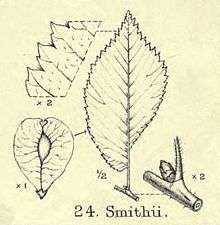''Ulmus'' × ''hollandica'' 'Smithii'
| Ulmus × hollandica 'Smithii' | |
|---|---|
 Leaf of 'Smithii' | |
| Hybrid parentage | U. glabra × U. minor |
| Cultivar | 'Smithii' |
| Origin | Nottingham, England |
The hybrid elm cultivar Ulmus × hollandica 'Smithii', commonly known as the Downton Elm,[1] was one of a number of cultivars arising from the crossing of the Wych Elm U. glabra with the Field Elm U. minor. The tree was originally planted at Downton Castle near Ludlow, as one of a batch, not all of them pendulous in habit, raised at Smith's Nursery, Worcester, England, from seeds obtained from a tree in Nottingham in 1810.[2]
'Smithii' or 'Downton Elm' is absent from Smith's 1887–88 catalogue, which contains 23 elms, unless it is one listed as 'Weeping English Elm'.[3]
Description
'Smithii' made a small to medium sized tree,[4] with ascending branches bearing long pendulous shoots, downy when young and developing corky ridges.[5] The oval leaves are dark green, glabrous and glossy above, < 8.5 cm long by 4.0 cm wide, downy beneath, and long acuminate at the apex. Bean described them as "coarsely double-toothed", with 14–16 pairs of lateral veins, and a petiole about 0.75 inches (19 mm) long.[6][5][4]
Cultivation
'Smithii' was grown at the Royal Victoria Park, Bath in the mid-19th century, where it was distinguished from the similar-looking Scampston Elm by its larger leaf,[7] at Kew Gardens, where one tree had reached a height of 35 ft (11 m), at the National Botanic Gardens, Glasnevin, Ireland, before the First World War,[2] and in the parkland of Westonbirt House, Gloucestershire, 60 feet (18 m) high and 5 feet (1.5 m) in girth by the 1920s.[8] Two trees said to be Downton Elm supplied by the Mount Hope Nursery (also known as the Ellwanger and Barry Nursery) of Rochester, New York, and planted c.1855, stood in that city for almost a century, one by the house of Edward Bausch, the other in the grounds of the John Williams School. The former was described in 1953 as "a superb tree, upwards of 75 feet in height", "a typical specimen with the characteristic long drooping branches". They were successful cloned in 1949, but it is not known whether the scions survive.[9]
Many 19th-century elms described in Elwes and Henry (1913) were excluded from standard 20th-century works such as those of Bean and Hillier, presumably as too rare, yet 'Smithii' continued to feature in later editions, suggesting it was an elm readers were likely to encounter in collections,[10][11] yet no captioned photographs nor verified survivors are known. The Direction des Espaces Verts et de l'Environnement (DEVE) - Ville de Paris lists a 'Smithii' at the Square Louise-Michel, Paris (1990).[12]
Putative specimen
A pruned U. × hollandica with leaves that match 'Smithii' herbarium specimens from Glasnevin and Kew (see External Links) forms part of an avenue in Eaton Road, Hove.
.jpg) Eaton Rd elm, Hove
Eaton Rd elm, Hove.jpg) Pendulous shoots of same
Pendulous shoots of same.jpg) Foliage of same
Foliage of same
Synonymy
References
- ↑ Knight, Thomas Andrew (1824). "Notice of a new variety of Ulmus suberosa". Transactions of the Horticultural Society of London. 5: 146–148. Retrieved 25 July 2017.
- 1 2 3 Elwes, Henry John; Henry, Augustine (1913). The Trees of Great Britain & Ireland. 7. pp. 1868–1869.
- ↑ 'Standard Ornamental Trees' in Forest, hardy ornamental trees, conifers, etc., Richard Smith & Co., Worcester, 1887–88, p.27
- 1 2 The Hillier Manual of Trees & Shrubs (6 ed.). Newton Abbot: David & Charles. 1994. p. 510. ISBN 071539942X.
- 1 2 Bean, William Jackson (1988). Trees and shrubs hardy in Great Britain (8 ed.). London: Murray. p. 659.
- ↑ Green, Peter Shaw (1964). "Registration of cultivar names in Ulmus". Arnoldia. Arnold Arboretum, Harvard University. 24 (6–8): 41–80. Retrieved 16 February 2017.
- ↑ Hanham, F. (1857). A Manual for the Park (Royal Victoria Park, Bath). Longman, London.
- ↑ Jackson, A. Bruce (1927). Catalogue of the Trees & Shrubs [at Westonbirt] in the Collection of the Late Lieut-Col. Sir George Lindsay Holford. London. p. 195.
- ↑ Williams, John (October 1953). "Edward Bausch and the Downton Elm". Bulletin of the Rochester Museum of Arts and Sciences. 26 (8): 126–127.
- ↑ Hilliers' Manual of Trees & Shrubs (Newton Abbot 1977)
- ↑ Bean, W. J., Trees and Shrubs Hardy in Great Britain (London 1988)
- ↑ Open Data Paris — Les arbres: Open Data Paris — Les arbres, accessdate: August 24, 2016
- ↑ Masters, W. (1831). Hortus Duroverni: Or, A Tabular and Descriptive Catalogue of Perennial Flower Roots, &c. Sold by W. Masters. p. 66. Retrieved 2017-07-06.
- ↑ Krüssmann, Johann Gerd (1962). Handbuch der Laubgehölze. 2. p. 537.
- ↑ Rehder, Alfred (1915). "Neue oder kritische Gehölze". Mitteilungen der Deutschen Dendrologischen Gesellschaft. 24: 217. Retrieved 27 July 2017.
- ↑ Loudon, John Claudius (1838). Arboretum et fruticetum Britannicum. 3. p. 1405.
External links
- "Herbarium specimen 295176, herbariaunited.org" Sheet labelled Ulmus montana var. Smithii, "Downton Elm" (Kew specimen, 1909; A. Ley)
- "Herbarium specimen - K000852708". The Herbarium Catalogue. Royal Botanic Gardens, Kew. Sheet labelled U. Smithii Henry, Glasnevin Botanical Gardens specimen (1911)
- "Herbarium specimen - WAG.1847113". Botany catalogues. Naturalis Biodiversity Center. Sheet labelled U. × hollandica pendula Smithii (The Hague specimen , ex. Kew, 1932)